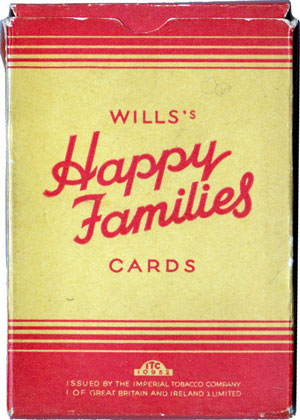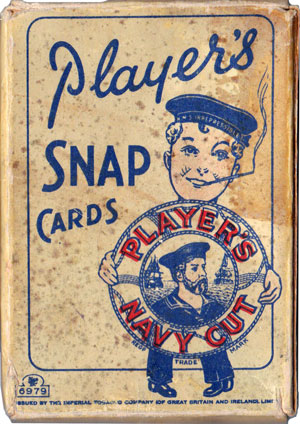Mardon, Son & Hall of Bristol, branch of the Imperial Tobacco Company
A division of Imperial Tobacco, they appear to have made cards almost exclusively for the cigarette token market, which flourished during the 1930s.
MARDON’S started out in 1823 when John Price established a small printing and engraving business in Bristol. In 1846, Price’s business partner John Harris invited his brother-in-law James Mardon to join the firm. James Mardon purchased two lithographic presses in 1849 and together with his son Heber Mardon the family firm grew into a large printing and packaging business. In the 1860s, the family firm – now with a brother-in-law on board – became known as Mardon, Son and Hall. In 1897 Mardon's built a new factory in Temple Gate which they called the Caxton Works.


Mardon, Son & Hall of Bristol (the printers and packers) were acquired by the Imperial Tobacco Company and became responsible for the production of most of their cigarette cards. During the early 1930s they also became involved in the manufacture of playing cards - both patience and standard sizes - for the ‘Wills Scheme’. The big tobacco companies were wooing the public with free gifts. Wills, of Imperial Tobacco, tucked two miniature cards into every packet of ten Goldflake or Capstan cigarettes, and each complete set posted to Wills's Bristol establishment entitled the sender to a pack of normal sized cards. These packs often had attractive pictorial back designs. John Waddington manufactured a large proportion of the full-sized packs, and De la Rue also produced a certain number, and the scheme enabled the firms to thrive at a time of severe economic downturn. The market became saturated with playing cards during the early to mid-1930s as a result of this scheme. Illustration right: the Wills Memorial Building in Bristol, designed in the Perpendicular Gothic style, was completed in 1925 in honour of Henry Overton Wills and funded through the fortunes which the Wills family made through tobacco. See Wikipedia article →
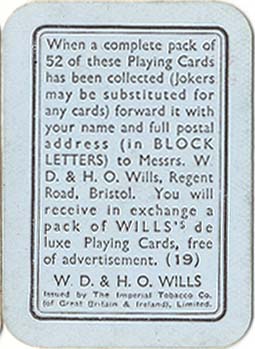 |
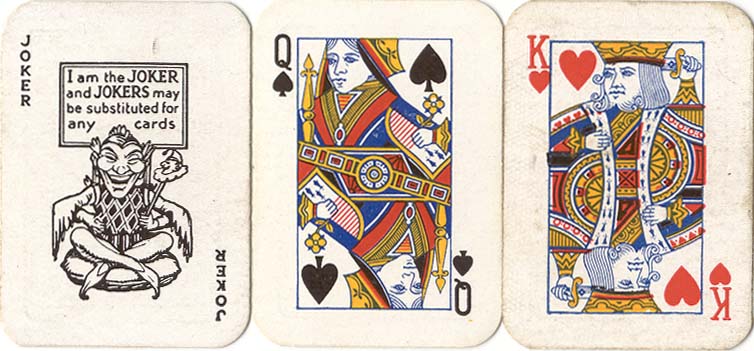 |
Left: miniature playing cards manufactured by Mardon Son & Hall for W.D. & H.O. Wills, 1932-4. When complete, these miniature packs could be exchanged for full-sized packs. |
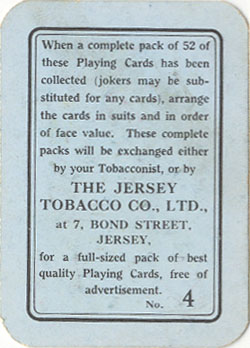 |
 |
Left: miniature playing cards manufactured by Mardon Son & Hall for the Jersey Tobacco Co. Ltd, 1933. The court cards are standard but the Ace of Spades is anonymous. Completed packs of miniature cards could be redeemed for full-sized packs as shown below - (click image to zoom). |

Above: a boxed patience set manufactured by Mardon, Son & Hall for W.D. & H.O. Wills' gift scheme, 1933. Books and attractive boxed set of playing cards could be redeemed by collecting complete packs of the miniature insert cards from tobacco products. The cards shown at the top of this page are illustrations from the book "Popular Card Games" by Lawrence H. Dawson, published by W.D. & H.O. Wills, printed by Mardon, Son and Hall, Bristol, 1933.
The Full Size Packs


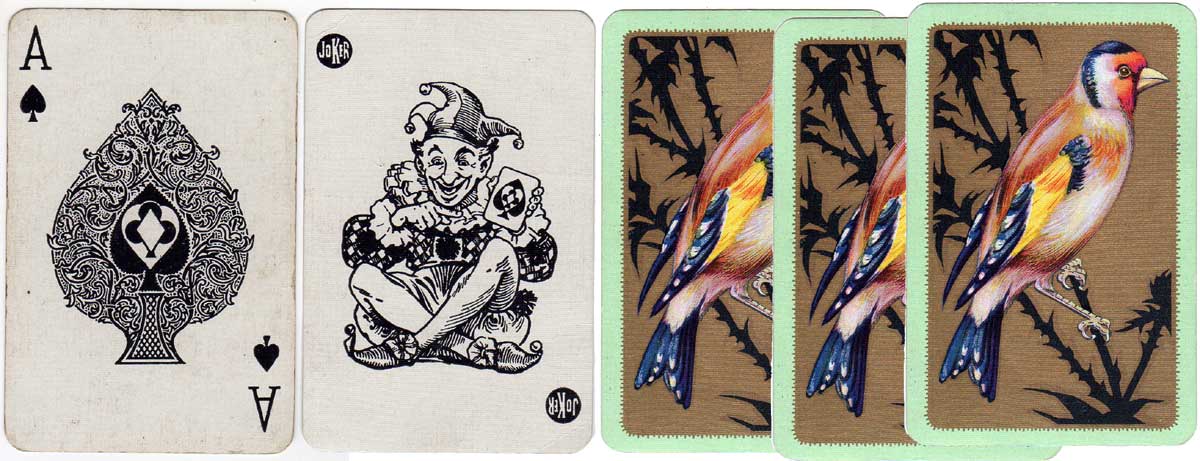
Above: standard packs which were produced for the Wills Tobacco scheme during the early 1930s.
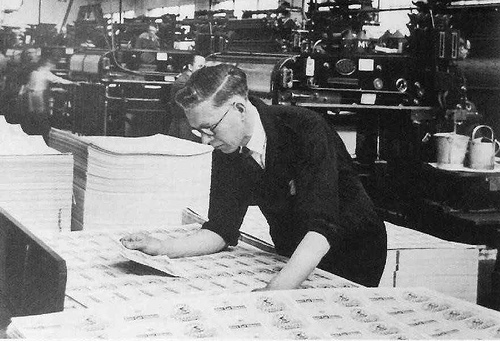
The photo shown left caption reads: "A division of Imperial Tobacco, they appear to have made cards almost exclusively for the cigarette token market, which flourished during the 1930s. Some advertising packs can also be found, e.g. Players Navy Cut cigarettes. A reciprocal arrangement may have existed with Waddingtons regarding playing card production during the early 1930s."
The Navy Cut cigarettes pack is shown below, with a rare special ace of spades.
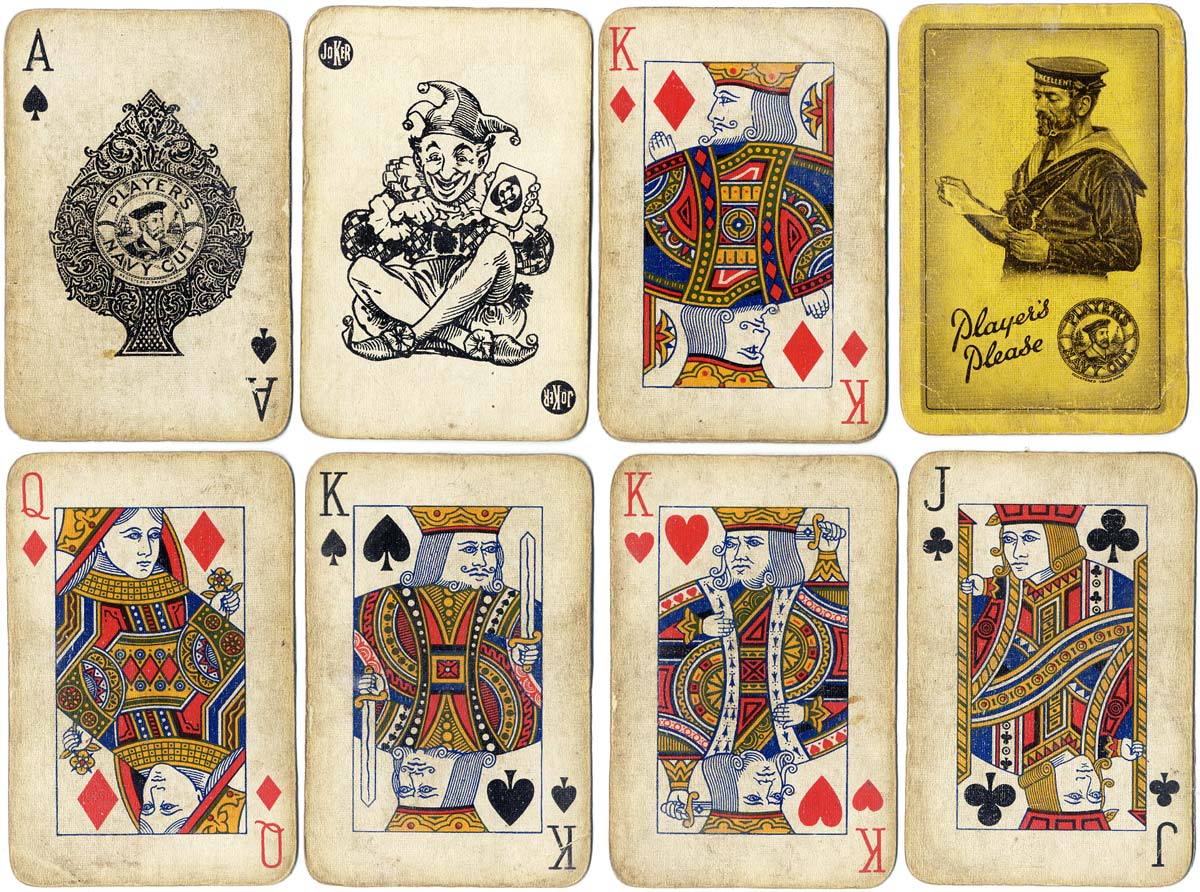

By Simon Wintle
Member since February 01, 1996
Founder and editor of the World of Playing Cards since 1996. He is a former committee member of the IPCS and was graphics editor of The Playing-Card journal for many years. He has lived at various times in Chile, England and Wales and is currently living in Extremadura, Spain. Simon's first limited edition pack of playing cards was a replica of a seventeenth century traditional English pack, which he produced from woodblocks and stencils.
Related Articles

Tarot Actuel 1984
Major arcana to cut out, issued with the French magazine Actuel, using photographic images.

Queen of Arts
A wide variety of women artists celebrated on cards with illustrations by Laura Callaghan.

The Glasgow Pack
Issued to celebrate Glasgow’s reign as European City of Culture in 1990, with city views and works o...

Cathedrals, Abbeys & Minsters playing cards
54 pictures of different famous cathedrals, abbeys and minsters in England and Wales.

Christmas Carols
Christmas Carols playing cards illustrated by Stuart Dilks

Pam is the Knave of Clubs
Playing cards as metaphors in 18th century art - from fate, chance and social hierarchy t...

Question and Answer Games
A card game called “Impertinent Questions and Pertinent Answers” was launched in the early 1920s by ...

Dr Sacheverell
Dr. Henry Sacheverell's impeachment in 1710 sparked widespread public unrest and political upheaval,...

Leadmill playing cards
Promotional pack for an arts centre in Sheffield with designs by Martin F. Bedford.

Agatha Christie and card games
Agatha Christie uses card-play as a primary focus of a story, and as a way of creating plots and mot...

English Heritage
52 different colour photos of historic sites managed by English Heritage.

The Malt Whiskies of Scotland
Three packs featuring photographs by Duncan McEwan of malt whisky distilleries in Scotland.

Typographic Playing Cards
Typographic Playing Cards designed by Jim Sutherland, c.2010.

76: Transitions: Hunt & Sons
Styles change and technology develops. This means that it's possible to see transition periods in th...

Gibson’s History of England
History without tears for young and old, 1920s.

Simpson (Piccadilly) playing cards
Innovative advertising pack for Simpsons of Piccadilly designed by André François.
Trending Articles
Popular articles from the past 28 days



